Nuts about squirrels: A Q&A with Mikel Delgado
Mikel Delgado on her road from punk and pigeons to cats and squirrels

October 27, 2016
Frisky fox squirrels are familiar to everyone on campus, but Mikel Delgado knows them best. A Ph.D. candidate in psychology, her research into their behavior helps us view squirrels as more than bushy-tailed rodents. Berkeley News recently caught up with Delgado, 45, a former punk rocker who is also a cat behavior consultant and science writer.
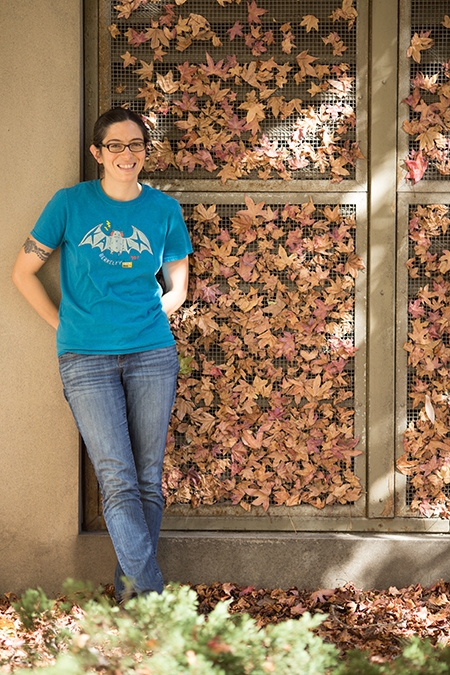
Mikel Delgado is a Ph.D. candidate in psychology at the Jacobs Lab for Cognitive Biology. (UC Berkeley photos by Ryan Hoang)
What’s so fascinating about squirrels?
Squirrels are really interesting because they have adapted to the human urban/suburban environment so well. Species that tend to succeed in these environments — like crows, raccoons and pigeons — are smart and flexible enough to take advantage of what the environment has to offer in terms of shelter, food (garbage) and new problems to solve.
Not only do squirrels wreak havoc by breaking into bird feeders, shutting down power grids, causing traffic accidents and chewing holes in people’s homes to nest in attics, but they still engage in all of their more ancestral behaviors. In other words, the campus squirrels, despite freshman handouts and trash cans, are still in large part controlled by the need to store food for the future, which is primarily what I study about them.

A National Science Foundation Graduate Research Fellowship Program awardee, Delgado studies the decisions squirrels make when storing food and the interplay between cache protection strategies, pilfering and cognition.
You grew up in Maine. Did your passion for animals start there?
I wasn’t the kid who wanted to be a veterinarian or a lion-tamer or anything. I’ve always thought squirrels were cute and interesting, and for many years, I fed the squirrels in my yard, mostly to entertain my indoor cats.
I actually got into punk rock as a teenager and became pretty frustrated with the small town life I led. There was some ‘80s/’90s angst going on for me because of Reagan, Bush, the AIDS crisis and the Iraq war. So, as a young person with anarcho-feminist leanings, leaving Maine for somewhere more left-leaning was definitely on my agenda.

The fox squirrel is larger than other tree squirrels in the United States.
I attended the University of Southern Maine for a few years before I realized I didn’t really know what I was doing or why I was in school. I was accruing debt and figured I would cut my losses by dropping out. What I really wanted to do was move to California and be an active part of the San Francisco punk scene. My mom saw it coming. So, in January of 1993, I packed up my belongings and got on an Amtrak train. My two cats, Kittums and Jesus, joined me a few months later. I was 21.
In San Francisco, I volunteered at a few punk rock collectives and played bass guitar in a bunch of bands. In 1995, I started a band called the Cinnamon Imperials, named after the red hots candy. I played in bands until 2008, when I was 37. I also was working at Rainbow Grocery, a worker-owned, collectively run health food store in the Mission District.
What led to your jump from punk rock to studying animals?
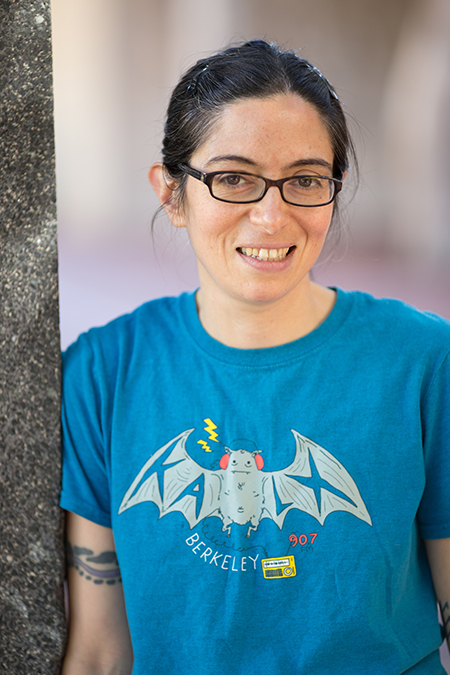
Cats and squirrels “are more complex than we give them credit for,” says Delgado.
I got my real introduction to animal behavior at the San Francisco SPCA, where I started working in 2000. I was there almost eight years, in the cat behavior department, and we were responsible for behavior modification for shelter cats who had issues such as fear and aggression. I’ve always been a cat lover, I’m pretty obsessed with cats. We provided education and counseling for the public and adopters and operated a behavior hotline. I also started reading veterinarian texts about behavior and reinforcement.
When I left the SPCA in 2008, a co-worker and I started a business partnership, Feline Minds, a consulting service for cat owners. We offer in-home, phone and Skype consultations for problems like introducing new cats into the home, litter box avoidance, cats keeping their owners up at night and aggression. We’ve also done consulting for local shelters and rescues, including Cat Town, the nation’s first café that pairs patrons with adoptable cats.
I eventually realized that working in an animal shelter was not the only way I could work with animals professionally and that I wanted to learn about behavior in a more formal setting, find a different way to learn.
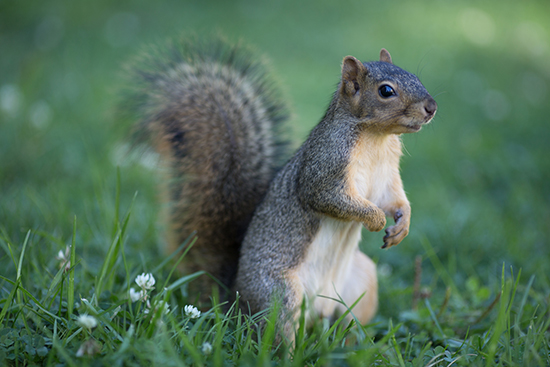
Squirrels are chubbier in the fall because trees are producing nuts, and they’re biologically wired to prepare for a harsh winter.
And then you studied pigeons?
I went back to college in 2008, at Cal State East Bay, to finish my bachelor’s degree in psychology. I worked in a pigeon lab and was lucky in that my undergraduate mentor let me ask questions about the behaviors of pigeons housed there. The recommended cage size for lab pigeons is about the size of a piece of paper — not much room for them to even stretch their wings. We recorded a lot of repetitive behaviors in their cages: pacing, trying to squeeze through the bars of their cages, trying unsuccessfully to stretch their wings. I was allowed to build a small aviary so the pigeons could have some social time, fly around, take baths, and play with toys when they weren’t participating in experiments.

Squirrels in Delgado’s studies are marked with a fur dye (see stripe on squirrel’s haunch) so they’re easier to spot. Squirrels do a full-body molt twice a year.
After that experience, I felt pretty sure I didn’t want to study animals in a lab, if I could work in the field instead. At an animal cognition conference, I met a former student from Berkeley’s Jacobs Lab for Cognitive Biology who was studying wild squirrels and pet dogs, and that was right up my alley. The Jacobs Lab piqued my interest, and I then met professor Lucia Jacobs at a presentation on squirrels. I started graduate school in 2010, with Lucia as my advisor, and I’m now finishing up my Ph.D.
Is Berkeley a great place to study squirrels?
Berkeley is THE place to study squirrels — first of all, because the fox squirrels here are amazing. The population is habituated to humans in a way that makes them easy to study. You can get close to them, and they are very trainable. For example, they’ll step on a scale so we can get their weight without having to handle them — and many of them are willing to interact with human-made objects, like mazes, that we might use in experiments. Also, Lucia is a font of knowledge about squirrels — she did her own dissertation research on a closely related species of tree squirrels (gray squirrels) and has spent the last 20-plus years perfecting methods for working with them.
Berkeley also has the Museum of Vertebrate Zoology and the Evolutionary Genetics Lab, plus experts in Bayesian/agent-based modeling and bio-mechanics — all resources that our lab has at some point drawn from. And the weather in Berkeley makes year-round data collection possible without frostbite.
How familiar are you with Berkeley’s squirrels, and how do you study them?

Researchers sometimes wear fanny packs full of peanuts to keep other squirrels away from those they’ve chosen to study.
My team and I don’t keep any squirrels in a lab; all of my research subjects have been free-ranging campus squirrels. They sleep in their own nests at night. Many of them are familiar with us, as we often give them food to either eat, bury or work for in our experiments, so we don’t usually have a problem finding volunteers.
There are around 20 to 30 squirrels around Tolman and Giannini halls that we study, and another 30 or so that we have studied in the past down in the Eucalyptus Grove. My research assistants and I mark them, photograph their marks, give them names, and track them in a database. Squirrels molt one to two times a year, so when they shed their hair, they lose their dye marks. That means I have to collect all my data between molts. There are a few squirrels with other distinguishing features, such as a weird tail or funky teeth, and they’ve been easy to track over the course of several years.

Alumnus Daniel Petrie (left) and undergraduate Aryan Sharif chat with Delgado while scanning the campus for caches of nuts buried by squirrels in their study. At times, Delgado has needed the help of 20 research assistants.
Your experiments compare squirrel and human behavior and also show how squirrels solve problems. Tell us about one of them.
To find out what happens to a nut after it’s buried by a squirrel — how long it stays where it was cached, if it gets moved, who moves it, and when and where it gets eaten — we gave 350 hazelnuts two summers ago to one squirrel, a female named Flame. We painted the nuts bright yellow so we could see her carrying them from a distance and know, if we saw a squirrel other than Flame with a yellow nut, that it had been stolen. Because Flame buried most of her nuts in one general area on campus, we could station ourselves nearby and see activity through binoculars. About 30 percent of Flame’s caches were stolen by other squirrels, and she relocated another 15 percent or so herself. But beyond that, it was impossible for us to track the caches without digging them up.
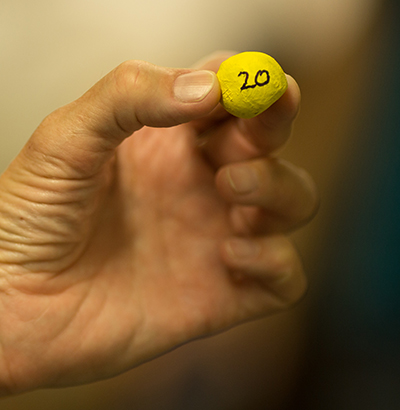
Each of 350 hazelnuts buried by Delgado’s squirrel study participants contains a microchip and was painted yellow and numbered.
So, I was awarded a National Science Foundation grant for funds to place pit tags inside the nuts so we could scan and check caches without disturbing them. We handed out over 300 nuts to 21 squirrels from February to April of this year and video-recorded the squirrels’ behaviors while they handled and buried the nuts. We also used GPS to record cache locations and tracked which other squirrels were around while they cached.
The biggest challenge was that the squirrels cached in such diverse areas that we couldn’t see very many cache movements. So we continue to rely on using the microchip reader to scan places where the nuts were buried, to see if they are still where they originally were buried, and then to sweep general areas to look for where other nuts may have been moved to or eaten. So far, we’ve found about 20 percent of the microchips from eaten nuts, and around 35 caches are still where they were originally buried.
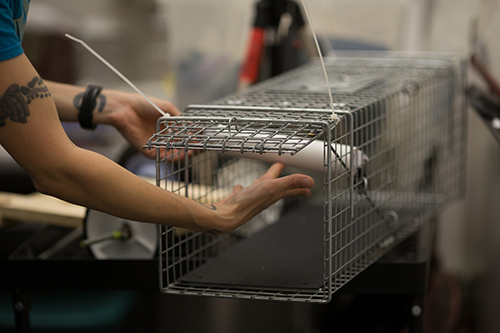
Delgado uses cages as tunnels to collect squirrel hairs with a roll of tape, not to trap the animals.
My grant also gave me funds to do some DNA analysis on the squirrels to determine how related they are. We collected hair samples by individually luring squirrels into a tunnel to eat nuts. The tunnel had a roll of double-sided tape at the top that they sat underneath. As they ate, their tail hairs got stuck to the tape, and a few were yanked out as they left. From those hair samples, we extracted DNA. I’m still analyzing that data.
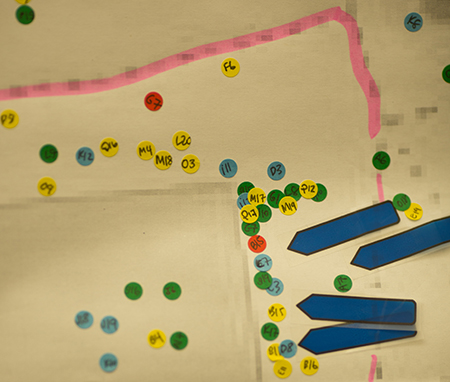
A map in the squirrel lab at Tolman Hall shows where squirrels in Delgado’s study have buried nuts.
Are you also studying the behavior of other animals?
I have co-authored some papers about human subjects, looking at human interactions/relationships with their pets and also at people’s attitudes about cat personality based on coat color. I recently was part of a collaborative review paper on the use of a type of enrichment (food puzzles) with pet cats and was part of a really cool art-science book, The Where, the Why, and the How. It paired scientists with artists to describe different phenomena, and I got to write the sections on why cats purr and why pigeons bob their heads when they walk. Right now, I’m helping someone write a book about cats.
What’s your ultimate goal, with your work?
It sounds awfully cliche to say I’d like to make the world a better place; but that would be great. I find our interactions with other animals — whether living with pets or co-existing with urban wildlife or the less pleasant side, like the meat industry — fascinating. I would love to keep pursuing the questions that interest me about animal behavior, while helping humans understand animals better, to see that both cats and squirrels are more complex than we give them credit for. To that end, I also do some science writing for the Berkeley Science Review, The Dodo and The Conversation, and I have my own blog, catsandsquirrels.com, with the goal of translating research about animal behavior for the lay person in a fun and informative way.
The campus squirrels attract a lot of attention. Any advice on how best to interact with them?

Delgado recommends tossing nuts and seeds to squirrels to avoid being bitten.
We don’t handle the squirrels, and we don’t feed them out of our hands. I recommend appreciating them from a distance — once they get close to your hand, they can’t really see what is the food and what is your hand — so they will bite whatever they think might be food. Their jaws are made for cracking heavy nuts open, so there is some force behind that bite. Squirrels don’t tend to carry rabies, but they can carry West Nile virus and other nasty things, so it’s really not a good idea to let them get that close. If you must feed them, toss them the food, and please, feed them squirrel-appropriate food, like nuts or seeds, not french fries and chocolate.
SEE MORE:
Fox squirrels’ tell-tail signs of frustration
Are you a dog person or a cat person?
Don’t be so fast to judge a cat by its color
Fox squirrels show long-term investment savvy when hoarding nuts